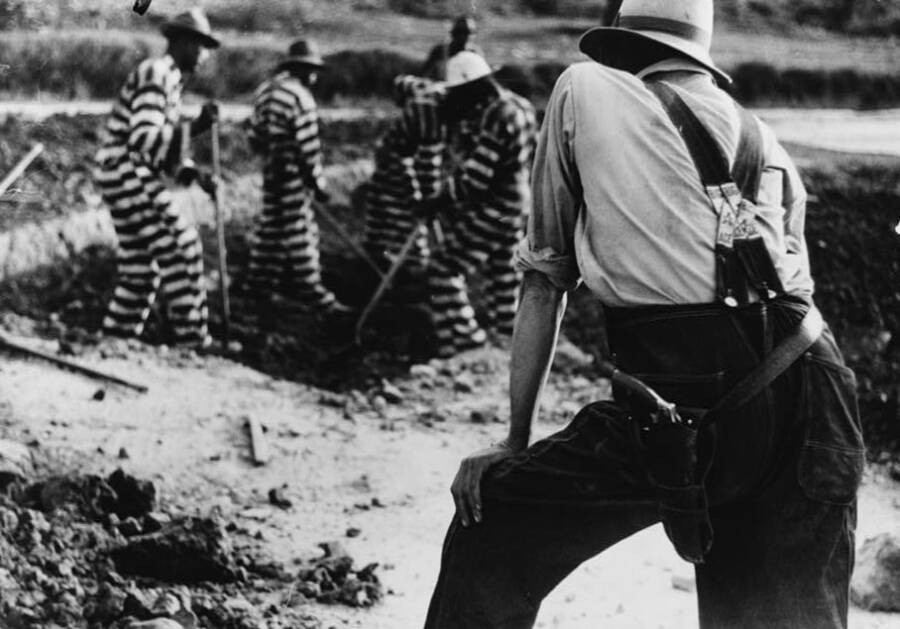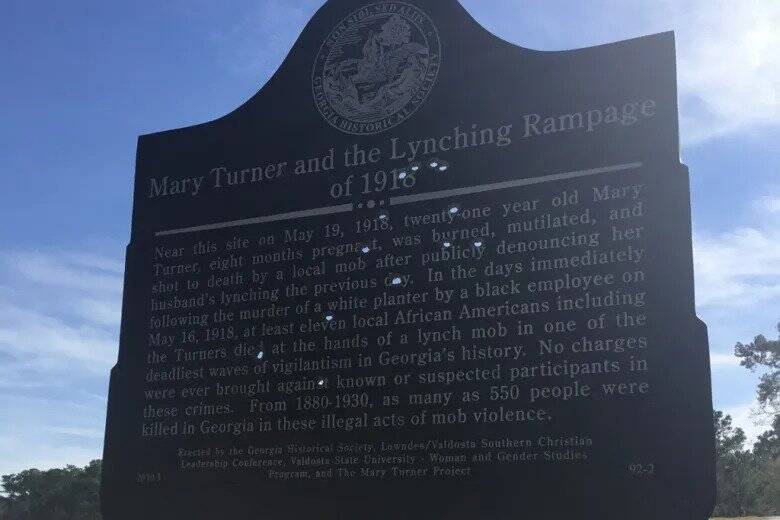On May 19, 1918, a white mob killed Mary Turner and her unborn baby in Brooks County, Georgia because she'd threatened to take legal action after the lynching of her husband.
Warning: This article contains graphic descriptions and/or images of violent, disturbing, or otherwise potentially distressing events.
Between 1877 and 1950, at least 4,075 Black Americans were murdered by lynch mobs in the South according to the Equal Justice Initiative. But one of the most horrific lynchings in U.S. history happened in 1918, when a white mob in Georgia brutally murdered a woman named Mary Turner who was eight months pregnant.
The mob turned on Mary after the murder of a white farmer named Hampton Smith. Smith was known to be abusive to Black workers, and had allegedly been killed by one, Sidney Johnson. Mary’s husband, Hayes, was accused of being Johnson’s accomplice, and was killed by the subsequent lynch mob.
But Mary didn’t take her husband’s lynching standing down. Though she had little legal power, Mary demanded that her husband’s killers be brought to justice. Instead, they marched straight to her door.
This is the story of Mary Turner’s death at the hands of a vicious lynch mob, and the impact her lynching had on the United States.
The Death Of Hampton Smith
On May 16, 1918, a white farmer named Hampton Smith was shot and killed in Brooks County, Georgia. Smith had a reputation among the Black people who worked for him for beating and abusing his workers. What’s more, The Augusta Chronicle reports, he would pay Black people’s legal fees, then force them to work off the payment on his farm.

Library of CongressPeonage and convict labor were used to force Black people into servitude after the Civil War.
Though this practice — known as peonage — was against federal law, it was practiced in Georgia until 1942. And Smith’s workers had had enough of it. The farmer was allegedly killed by a man named Sidney Johnson, a Black man working to pay off the legal fees he’d incurred for “rolling dice,” according to the Equal Justice Initiative.
Smith’s death incited a reign of terror against Black people across Brooks County and nearby Lowndes County. As a white mob hunted for Johnson, they lynched nearly a dozen other Black men, including Hayes Turner. Hayes, like Johnson, had worked for Smith, and the mob accused him of being Johnson’s accomplice.
On May 18, Hayes was lynched by the mob. And his pregnant wife Mary Turner — who was 21 years old at the time — fought back. According to the Howard Center For Investigative Journalism, she threatened to take legal action against Hayes’s killers. But her threats only drew the mob to her door.
The Lynching Of Mary Turner
On May 19, 1918, a white mob marched to Mary Turner’s door. Her “talk,” the white-owned Valdosta Daily Times reported at the time, had “enraged” the mob who “took exceptions to her remarks as well as her attitude.”

Mary Turner ProjectShortly after this memorial plaque was erected in Mary Turner’s memory, someone shot it through with bullets. It has since been removed.
Mary fled when she heard that the mob wanted to “teach her a lesson,” but they soon caught up to her. Several hundred people gathered as she was dragged to Folsom Bridge, which separated Brooks County and Lowndes County. There, Mary was hung by her ankles.
The bloodthirsty mob poured gasoline over her and lit her on fire. “She writhed in agony and the mob howled in glee,” the NAACP reported that September, according to the Howard Center For Investigative Journalism. Then, in a horrific act of cruelty, someone cut open her abdomen, and Mary’s unborn baby fell onto the ground.
A member of the mob stomped on the baby’s head, killing it instantly by smashing its skull. The mob then fired their guns at Mary’s burning body, leaving her corpse riddled with hundreds of bullets.
Later that night, Mary and her baby would be buried near the scene of their murder. But their gruesome deaths would not soon be forgotten.
The Impact Of Mary Turner’s Death
Mary Turner’s killers never faced any punishment. But Mary’s story drew outrage from across the country.
The incident galvanized anti-lynching activists, and that the NAACP and the Commission on Interracial Cooperation (CIC) used Mary’s death in their anti-lynching pamphlets to emphasize the connection between lynching and white supremacy (and not, as argued at the time, Black criminality).

Mary Turner ProjectAfter the memorial marker was attacked, it was replaced with this simple steel cross.
Her gruesome death, and her gender, put the horrors of lynching on full display, and the Zinn Project additionally reports that Mary’s death was used to raise support for the 1922 Dyer Anti-Lynching Bill. (This bill did not become law until almost 100 years later in December 2018.)
“Mary Turner possibly became a symbol that could resonate because of her gender, and because of her body — her pregnant body — in a way that Rosa Parks was able to resonate when other bodies had been on buses for years,” Jamie Landau, a professor of communication arts at Valdosta State University, told the Howard Center For Investigative Journalism.
Though other events — such as the lynching of Emmett Till — overshadowed Mary Turner’s death in the years to come, her lynching remains a painful wound for many, especially in Georgia. But not everyone wants to acknowledge the state’s history of lynching.
Within a year after a memorial plaque was erected for Mary Turner in 2010, someone shot it up with bullets. Today, a simple steel cross stands at the site of her death which reads: “Mary Turner 1918.”
Mary Turner’s gruesome lynching continues to have a “profound legacy,” Phillip Williams, the founder and director of the Wiregrass Region Digital History Project, told the Howard Center For Investigative Journalism.
“[U]pon local history, racial history,” Williams added, “but [also] just Black history in the U.S. in general because of how absolutely horrific it was.”
After reading about the horrific lynching of Mary Turner, discover the story behind the poignant anti-lynching ballad Strange Fruit. Or, go inside the gruesome — and largely forgotten — Tulsa Massacre of 1921.






